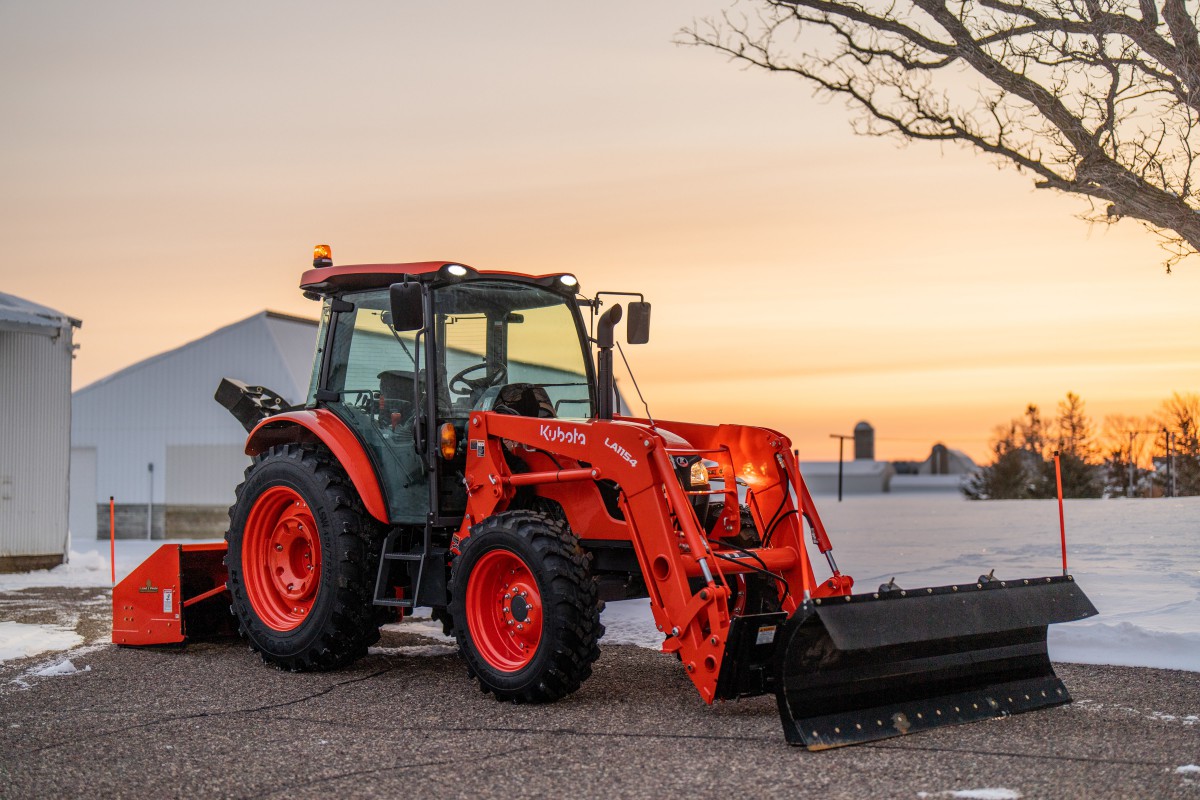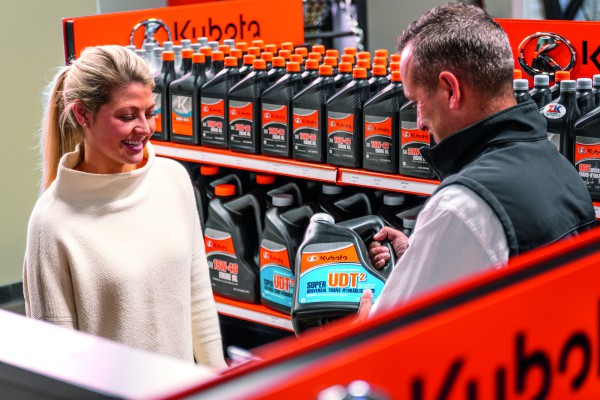
Winterizing Kubota equipment prevents damage and ensures smooth operation when warmer weather returns. Cold temperatures affect fluids, batteries, and engine components, leading to performance issues and costly repairs. Proper maintenance extends equipment life and reduces downtime.
Ignoring winterization can cause frozen fuel lines, battery failure, and cracked hoses. Preparing in advance protects your investment and keeps your machine in peak condition. Whether storing equipment or using it in winter, following key maintenance steps ensures reliable performance.
This guide provides a step-by-step process for winterizing Kubota tractors, mowers, and utility vehicles.
7 Steps to Winterizing Your Kubota Equipment
Winter maintenance is essential to prevent breakdowns and costly repairs. Cold temperatures affect engine performance, fluids, and moving parts. Preparing your Kubota equipment ensures smooth operation when spring arrives.
A structured winterization plan minimizes downtime and keeps your tractor ready for work. Proper maintenance includes checking fluids, cleaning parts, protecting the battery, and ensuring safe storage. Each step reduces the impact of harsh winter conditions.
1. Check and Replace Fluids
Cold weather reduces fluid effectiveness, causing engine strain and hydraulic failures. Maintaining optimal fluid levels and using winter-grade options helps prevent performance issues.
Engine Oil

Thicker oil struggles to flow in cold temperatures. Using winter-grade engine oil ensures smooth lubrication and prevents internal damage.
-
Drain old engine oil and replace it with Kubota-recommended winter oil.
-
Use synthetic blends that remain fluid in freezing conditions.
-
Check the oil filter and replace it if necessary.
Coolant and Antifreeze
Antifreeze protects the cooling system from freezing. Low coolant levels increase the risk of engine damage.
-
Check the coolant reservoir for proper levels.
-
Use a 50/50 antifreeze-to-water mix for maximum protection.
-
Flush and replace old coolant if it appears dirty or discolored.
Hydraulic Fluids
Cold weather thickens hydraulic fluid, making lifting and movement sluggish.
-
Inspect hydraulic fluid levels before storage.
-
Use low-viscosity winter hydraulic fluid for smoother operation.
-
Check hoses and seals for leaks before refilling.
Fuel Considerations
Diesel fuel gels in extreme cold, leading to clogged lines and engine failures.
-
Use winter-blend diesel to prevent fuel thickening.
-
Add fuel stabilizer to reduce degradation in stored equipment.
-
Keep fuel tanks full to prevent condensation buildup.
Proper fluid management keeps your Kubota running efficiently all winter.
2. Clean Equipment Thoroughly
Dirt and debris trap moisture, leading to rust, corrosion, and mechanical wear. A thorough cleaning before winter storage protects components.
Exterior Cleaning
Mud and dust cause buildup on metal parts, accelerating corrosion.
-
Use a pressure washer to remove dirt and debris.
-
Pay attention to undercarriage, wheel wells, and hidden areas.
-
Dry equipment completely to avoid water freezing in cracks.
Grease and Oil Residue Removal
Excess grease attracts dust and grit, leading to premature wear.
-
Wipe down greased joints and reapply fresh lubricant.
-
Remove oil buildup on the engine and hydraulic components.
-
Check for fluid leaks while cleaning.
Cabin and Interior Maintenance
Dust and moisture damage electrical components inside the cab.
-
Vacuum the floor and seat areas to prevent mildew.
-
Wipe down dashboards, screens, and controls.
-
Store tools and manuals in a dry compartment.
A clean tractor stores better and remains in peak condition for spring.
3. Inspect and Maintain Belts and Hoses
Cold temperatures harden rubber belts and hoses, increasing cracking and breakage risks. Regular inspection prevents costly failures.
Checking Belts
Loose or worn belts cause inefficient performance and power loss.
-
Look for cracks, fraying, and signs of wear.
-
Ensure belts are properly tensioned to prevent slipping.
-
Replace any damaged or stretched belts before winter.
Inspecting Hoses
Hoses become brittle in freezing weather, increasing leak risks.
-
Check for stiffness, bulging, or weak spots.
-
Ensure hose clamps are secure to prevent leaks.
-
Replace old hoses that appear dry or cracked.
Belts and hoses must remain flexible to ensure smooth operation and equipment longevity, and maintaining Kubota equipment efficiently helps prevent wear and breakdowns.
4. Protect the Fuel System
Cold weather affects fuel stability, leading to hard starts and clogged lines. Preventative measures keep the engine running efficiently.
Diesel Fuel Treatment
Diesel fuel gels at freezing temperatures, blocking fuel injectors.
-
Use anti-gel additives to maintain fuel flow.
-
Store diesel in a temperature-controlled environment.
-
Keep the fuel tank at least half full to prevent condensation.
Gasoline Stabilization
Gasoline breaks down over time, causing starting problems.
-
Add a stabilizer to prevent fuel degradation.
-
Run the engine for five minutes after adding the stabilizer.
-
Drain excess fuel if storing for extended periods.
A treated fuel system prevents costly engine repairs.
5. Store Equipment Properly
Proper storage protects equipment from snow, ice, and extreme temperatures. Choosing the right storage method reduces long-term damage.
Indoor Storage
Keeping equipment inside a garage or barn is ideal.
-
Prevents snow buildup and exposure to moisture.
-
Reduces temperature fluctuations that affect components.
-
Keeps batteries and electrical parts safe from extreme cold.
Covered Storage
A sheltered structure or tarp provides moderate protection.
-
Use a weatherproof tarp to block moisture.
-
Elevate equipment on pallets to avoid ground contact.
-
Allow for ventilation to prevent condensation buildup.
Outdoor Storage Precautions
If outdoor storage is necessary, take extra protective measures.
-
Apply rust protectant to metal parts.
-
Cover the exhaust pipe to prevent moisture entry.
-
Park on gravel or concrete instead of soft ground.
Correct storage extends the lifespan of your Kubota equipment.
6. Care for the Battery
Cold weather drains battery power, leading to starting issues. Proper maintenance ensures reliable performance.
Disconnecting the Battery
If storing equipment long-term, disconnect the battery.
-
Prevents power drain from idle systems.
-
Reduces corrosion buildup on terminals.
-
Keeps the battery stable in freezing weather.
Using a Battery Maintainer
A trickle charger keeps batteries charged without overloading them.
-
Prevents battery freezing and power loss.
-
Extends battery lifespan by maintaining voltage.
-
Ensures immediate startup when winter ends.
Regular battery maintenance prevents replacement costs.
7. Grease and Lubricate Moving Parts
Lubrication prevents stiffness and metal wear in cold weather. Ensuring all moving parts are well-greased improves operational efficiency.
Key Lubrication Points
Winter cold hardens grease, causing increased friction.
-
Grease pivot points, axles, and steering joints.
-
Lubricate PTO shafts and linkage connections.
-
Apply protective oil coatings to exposed metal parts.
Hydraulic System Maintenance
Hydraulic components need extra care in freezing temperatures.
-
Use low-temperature hydraulic oil for smooth operation.
-
Check cylinder seals and hoses for leaks.
-
Operate the system briefly before shutdown to distribute lubricant.
Lubrication ensures efficient, smooth performance all winter.
Proper winterization protects your investment and prepares your Kubota for spring. Checking fluids, belts, and batteries prevents costly repairs and downtime. Safe storage and fuel system care ensure efficient operation when temperatures drop.
A well-maintained Kubota handles winter stress better and is ready for peak performance when warm weather returns.
Storage Options to Protect Equipment from the Elements
Proper storage protects Kubota machinery from harsh winter conditions. Cold temperatures, moisture, and ice can cause mechanical damage and corrosion. Choosing the right storage method prevents premature wear and costly repairs.
Each storage option offers different levels of protection. Indoor storage provides the best safety, while covered and outdoor storage require additional precautions. Taking preventive measures ensures equipment remains in optimal condition.
1. Indoor Storage: Best for Maximum Protection
Keeping Kubota machinery inside a barn or garage provides the highest level of protection. Controlled environments reduce exposure to extreme temperatures and moisture.
-
Why Indoor Storage is Ideal
-
Cold weather affects engine performance and fluid efficiency. Storing equipment indoors prevents freezing-related malfunctions.
-
Prevents snow, ice, and wind exposure, reducing wear.
-
Lowers moisture accumulation, preventing rust and corrosion.
-
Maintains a consistent temperature, reducing battery drain.
-
-
Steps for Proper Indoor Storage
-
Clean the storage area to remove dust, debris, and rodents.
-
Cover equipment with a breathable tarp to reduce dust buildup.
-
Ensure proper ventilation to prevent moisture buildup.
-
-
Ideal Indoor Storage Locations
-
Barns and farm garages provide ample space and security.
-
Workshops with insulation help maintain stable temperatures.
-
Commercial storage facilities offer climate-controlled environments.
Indoor storage reduces maintenance efforts and prevents winter-related damage.
-
2. Covered Storage: Protection from Snow and Ice
If indoor space is unavailable, covered storage offers moderate protection. Using a shed, carport, or tarp-covered structure prevents direct exposure to winter conditions.
-
Benefits of Covered Storage
-
Shields equipment from direct snow and ice buildup.
-
Limits exposure to heavy winds and freezing rain.
-
Keeps machinery dry, reducing rust and moisture damage.
-
-
How to Optimize Covered Storage
-
Use a heavy-duty tarp for added coverage.
-
Keep ventilation open to avoid moisture accumulation.
-
Place equipment on pallets or concrete blocks to reduce ground contact.
-
-
Best Covered Storage Options
-
Metal or wooden sheds offer semi-enclosed protection.
-
Portable carports shield against snow and wind.
-
Pole barns with open sides provide partial coverage for large equipment.
Covered storage balances affordability and protection, keeping Kubota machinery in good condition.
-
3. Outdoor Storage: Last Resort with Extra Precautions
If storing Kubota machinery outdoors, additional steps reduce exposure to harsh elements. Winter conditions increase wear and tear, making proper preparation crucial.
-
Challenges of Outdoor Storage
-
Snow accumulation adds weight and stress to machinery.
-
Freezing rain leads to ice buildup on moving parts.
-
Wind exposure accelerates paint chipping and rust formation.
-
-
Essential Outdoor Storage Precautions
-
Use a high-quality, weather-resistant tarp to cover the machine.
-
Park on gravel or concrete to avoid mud and ground moisture contact.
-
Apply rust inhibitors on exposed metal components.
-
Cover exhaust pipes and air intakes to prevent moisture entry.
-
Check regularly for ice buildup and clear snow off surfaces.
-
-
Improving Outdoor Storage Conditions
-
Position equipment next to a windbreak, such as a fence or wall.
-
Keep attachments and smaller parts stored separately indoors.
-
Elevate equipment slightly to prevent moisture absorption from the ground.
Outdoor storage requires consistent monitoring to prevent weather-related damage.
-
Choosing the Best Storage Method for Your Needs
Selecting the right winter storage option depends on space availability and climate conditions.
|
Storage Method |
Protection Level |
Best For |
|
Indoor Storage |
Maximum protection |
Long-term winter storage, large equipment |
|
Covered Storage |
Moderate protection |
Mid-sized equipment, limited indoor space |
|
Outdoor Storage |
Minimum protection |
Last resort with extra precautions |
Proper storage extends the lifespan of Kubota machinery, ensuring it stays in excellent condition year-round.
Battery Care, Fuel Treatment, and Tire Maintenance

Proper care of batteries, fuel systems, and tires is essential to keep Kubota machinery ready for use after winter storage. Cold temperatures can degrade these components, leading to performance issues or breakdowns. Following these maintenance steps ensures reliability and reduces repair costs, which is why Kubota equipment saves time and money when routine upkeep is performed consistently.
Battery Care
Cold weather drains batteries faster and can cause permanent damage if not addressed.
-
Remove the battery from the machine and store it in a warm, dry location.
-
Check the charge level monthly and recharge if it drops below 75%.
-
Clean terminals with a wire brush to prevent corrosion.
Proper battery care prevents starting issues when spring arrives.
Fuel Treatment
Fuel left in Kubota machinery over winter can degrade, clogging systems and reducing engine efficiency.
-
Add a fuel stabilizer to the tank and run the engine for 10 minutes to circulate it.
-
Fill the tank to 90% capacity to minimize condensation and air exposure.
-
Drain fuel from carburetors or lines if recommended for your model.
Treated fuel keeps the engine running smoothly after storage.
Tire Maintenance
Tires can develop flat spots or cracks from prolonged inactivity in cold conditions.
-
Inflate tires to the recommended PSI before storage (check your Operator’s Manual).
-
Park on a level surface and avoid direct contact with wet ground.
-
Rotate tires monthly or elevate the machine to reduce pressure on them.
Maintaining tires prevents costly replacements and ensures safe operation.
Additional Tips
Consult your Kubota Operator’s Manual for model-specific instructions on battery, fuel, and tire care. Regular checks during storage keep these components in top shape, extending the life of your Kubota machinery.
Maximizing Winter Protection for Your Kubota Equipment
Winterizing your Kubota equipment prevents costly repairs and ensures a smooth start in spring. Checking fluids, batteries, belts, and tires improves performance and longevity. Proper storage shields equipment from extreme weather, while fuel and lubrication maintenance prevent engine damage.
Preparing early avoids last-minute problems and downtime. For added protection, visit a Kubota dealership for a pre-season inspection. Expert technicians identify potential issues and ensure your equipment is winter-ready.
Take action now to protect your investment and keep your Kubota equipment running at peak performance all year round.

